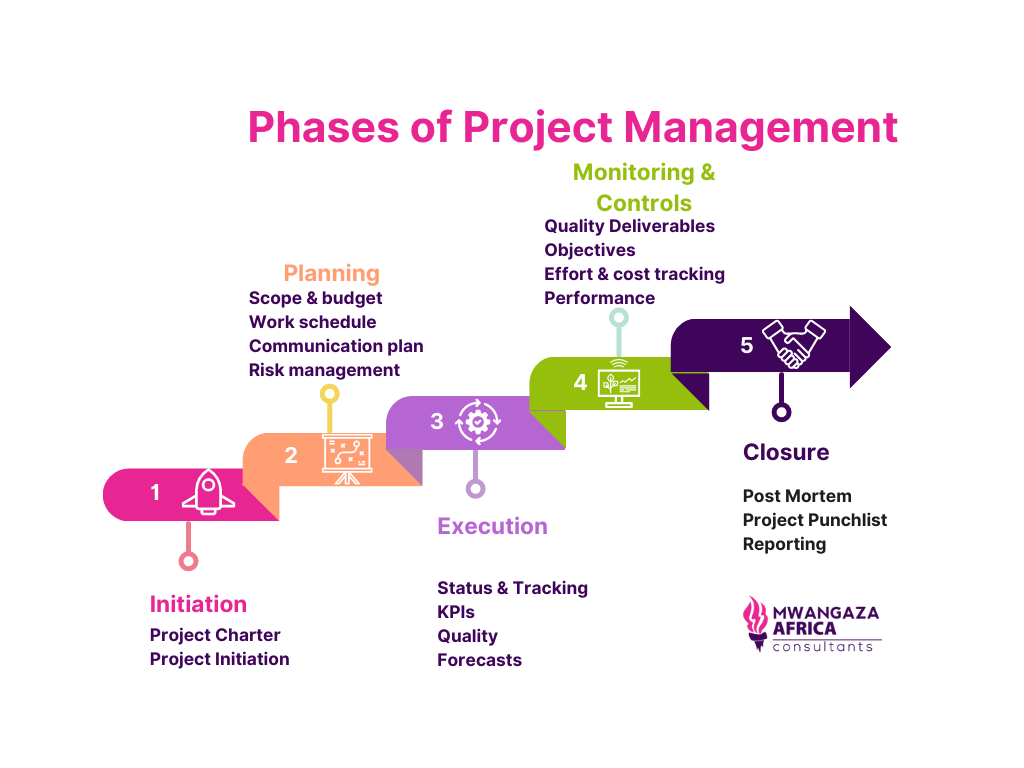Introduction
Every successful project, especially in the IT industry, is a result of thorough planning and effective execution through a series of structured steps. Understanding the project management phases can make all the difference in turning a complex idea into a successful outcome. In this blog post, we will guide you through the project lifecycle, from initiation to closure, and explore how each phase is critical for effective IT project planning.
1. Initiation Phase
The initiation phase is where the project begins. It involves defining the project’s purpose, objectives, and feasibility. During this phase, the project manager identifies key stakeholders, clarifies the project scope, and secures approval from decision-makers. The project charter, a crucial document that outlines the project’s goals, scope, and high-level requirements, is typically created here.
For IT projects, this phase is especially important as it helps determine whether the proposed solution is aligned with the company’s strategic goals and whether it is technologically feasible. Effective initiation lays a strong foundation for the entire project.
2. Planning Phase
The planning phase is all about creating a detailed roadmap for the project. This involves defining the project’s scope, setting milestones, allocating resources, estimating costs, and building a schedule. Effective IT project planning is essential for managing both the complexities of technology and the expectations of stakeholders.
In this phase, the project manager also identifies potential risks and outlines strategies to mitigate them. A clear plan ensures everyone involved understands their roles and responsibilities, making it easier to coordinate efforts and track progress.
3. Execution Phase
During the execution phase, the project team puts the plan into action. Deliverables are produced, resources are allocated, and tasks are carried out to meet the project’s goals. For IT projects, this could mean developing software, implementing systems, or conducting migrations.
Project managers play a vital role in this phase, facilitating communication, managing resources, and resolving issues as they arise. Successful execution requires teamwork, effective leadership, and a commitment to meeting the project scope and objectives.
4. Monitoring and Control Phase
The monitoring and control phase runs concurrently with execution, ensuring that the project stays on track. This phase involves measuring project performance, tracking key metrics, and comparing actual progress against the project plan. If there are deviations, corrective actions are taken to realign the project with its goals.
Effective monitoring is key to managing the project lifecycle effectively. In IT projects, this often involves quality assurance testing, budget tracking, and ensuring timelines are adhered to. Regular updates to stakeholders help maintain transparency and build confidence in the project’s progress.
5. Closure Phase
The closure phase marks the completion of the project. During this phase, final deliverables are handed over, documentation is completed, and all stakeholders formally accept the outcome. For IT projects, this could involve handing over the software or system to the client, conducting final user training, and providing ongoing support plans.
A project retrospective or lessons learned meeting is also held during this phase, providing valuable insights for future projects. Formal closure is important as it ensures all contractual obligations are fulfilled, and the project is officially marked as complete.
Conclusion
Navigating the five phases of project management effectively ensures that your project meets its goals while staying within scope, time, and budget constraints. From the initial idea in the initiation phase to delivering the final product in the closure phase, each part of the project lifecycle is essential for achieving project success.
Whether you are managing a small internal IT upgrade or a complex software development project, understanding these phases helps streamline processes and mitigate risks. Effective IT project planning, thorough execution, and consistent monitoring are key to a successful outcome.
Ready to dive deeper into the world of project management? Stay tuned for more insights on mastering the project management process!
Keywords: Project management phases, Project lifecycle, IT project planning.


